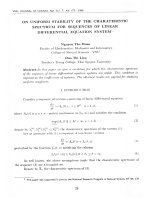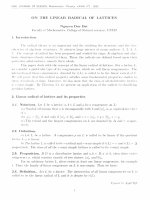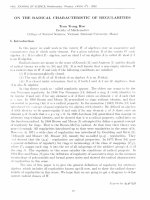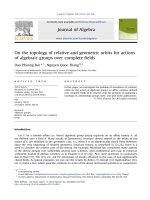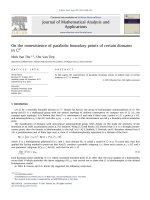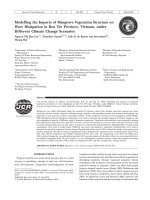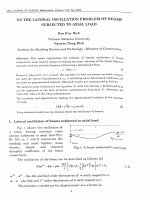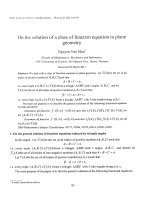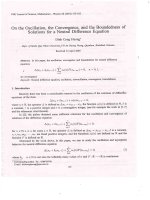DSpace at VNU: On the nonexistence of parabolic boundary points of certain domains in C{double-struck} 2
Bạn đang xem bản rút gọn của tài liệu. Xem và tải ngay bản đầy đủ của tài liệu tại đây (158.06 KB, 7 trang )
J. Math. Anal. Appl. 389 (2012) 908–914
Contents lists available at SciVerse ScienceDirect
Journal of Mathematical Analysis and
Applications
www.elsevier.com/locate/jmaa
On the nonexistence of parabolic boundary points of certain domains
in C2
Ninh Van Thu ∗,1 , Chu Van Tiep
Department of Mathematics, Vietnam National University at Hanoi, 334 Nguyen Trai str., Hanoi, Viet Nam
a r t i c l e
i n f o
a b s t r a c t
Article history:
Received 31 October 2011
Available online 28 December 2011
Submitted by A.V. Isaev
In this paper, the nonexistence of parabolic boundary points of infinite type of certain
domains in C2 is showed.
© 2011 Elsevier Inc. All rights reserved.
Keywords:
Parabolic boundary point
Pseudoconvex domains
Infinite type
1. Introduction
Let Ω be a smoothly bounded domain in Cn . Denote by Aut(Ω) the group of holomorphic automorphisms of Ω . The
group Aut(Ω) is a topological group with the natural topology of uniform convergence on compact sets of Ω (i.e., the
compact-open topology). It is known that Aut(Ω) is noncompact if and only if there exist a point x ∈ Ω , a point p ∈ ∂Ω ,
and automorphisms ϕ j ∈ Aut(Ω) such that ϕ j (x) → p as j → ∞. In this circumstance we call p a boundary orbit accumulation
point.
The classification of domains with noncompact automorphism group relies deeply on the study the geometry of the
boundary at an orbit accumulation point p. For instance, Wong [12] and Rosay [13] showed that if p is a strongly pseudoconvex point, then the domain is biholomorphic to the ball. In [1–4] E. Bedford, S. Pinchuk, and F. Berteloot showed that if
∂Ω is pseudoconvex and of finite type near p, then Ω is biholomorphically equivalent to a domain of the form
M P = ( w , z) ∈ C2 : Re w + P ( z, z¯ ) < 0 ,
where P is a homogeneous polynomial in z and z¯ . Each domain M P is called a model of Ω at p. To prove this, they first
applied the Scaling method to point out that Aut(Ω) contains a parabolic subgroup, i.e., there exist a point p ∞ ∈ ∂Ω and a
one-parameter subgroup {ht }t ∈R ⊂ Aut(Ω) such that for all z ∈ Ω
lim ht ( z) = p ∞ .
(1.1)
t →±∞
Each boundary point satisfying (1.1) is called a parabolic boundary point of Ω . After that, the local analysis of a holomorphic
vector field H which generates the above subgroup {ht }t ∈R was carried out to show that Ω is biholomorphic to the desired
homogeneous model.
In 1993, R. Greene and S.G. Krantz [6] suggested the following conjecture.
*
1
Corresponding author.
E-mail addresses: (T. Ninh Van), (T. Chu Van).
The research of the author is supported by an NAFOSTED grant of Viet Nam.
0022-247X/$ – see front matter
doi:10.1016/j.jmaa.2011.12.034
©
2011 Elsevier Inc. All rights reserved.
T. Ninh Van, T. Chu Van / J. Math. Anal. Appl. 389 (2012) 908–914
Greene–Krantz Conjecture. If the automorphism group Aut(Ω) of a smoothly bounded pseudoconvex domain Ω
pact, then any orbit accumulation point is of finite type.
909
Cn is noncom-
The main results around this conjecture are due to R. Greene and S.G. Krantz [6], K.T. Kim [8], K.T. Kim and S.G. Krantz
[9,10], H. Kang [7], M. Landucci [11], and J. Byun and H. Gaussier [5].
In what follows, let P ∞ (∂Ω) be the set of all points in ∂Ω of infinite type. In [11], M. Landucci proved that the automorphism group of a domain is compact if P ∞ (∂Ω) is a closed interval on the real normal line in a complex space with
dimension 2. In [5], J. Byun and H. Gaussier also proved that there is no parabolic boundary point if P ∞ (∂Ω) is a closed interval transerval to the complex tangent space at one boundary point. In [7], H. Kang showed that the automorphism group
of the bounded domain Ω = {( z, w ) ∈ C2 : | z|2 + P ( w ) < 1} is compact, where the function P ( w ) is smooth and vanishes
to infinite order at w = 0. Recently, K. T. Kim and S.G. Krantz [10] considered the pseudoconvex domain Ω ⊂ C2 where the
local defining function of Ω in a neighborhood of the point of infinite type (0, 0) takes the form ρ ( z) = Re z1 + ψ( z2 , Im z1 ).
They pointed out that the origin is not a parabolic boundary point (see [10, Theorem 4.1]). Their proof based on the vanish2
ing to infinite order at the origin of the function ψ . But, in general it is not true, e.g., ψ( z2 , Im z1 ) = e −1/|z2 | + | z2 |4 · | Im z1 |2 .
The aim of this paper is to prove the following theorem which shows that there is no parabolic boundary point of infinite
type if P ∞ (∂Ω) is a closed curve.
Theorem 1.1. Let Ω ⊂ C2 be a bounded pseudoconvex domain in C2 and 0 ∈ ∂Ω . Assume that
(1) ∂Ω is C ∞ -smooth and satisfies Bell’s condition R.
(2) There exists a neighborhood U of 0 ∈ ∂Ω such that
Ω ∩ U = ( z1 , z2 ) ∈ C2 : ρ = Re z1 + P ( z2 ) + Q ( z2 , Im z1 ) < 0 ,
where P and Q satisfy the following conditions
(i) P is smooth, subharmonic and strictly positive at all points different from the origin, where it vanishes to any order, i.e.,
P (z )
limz2 →0 |z |2N = 0, ∀ N 0,
2
(ii) Q ( z2 , Im z1 ) is smooth and can be written as Q ( z2 , Im z1 ) = | z2 |4 | Im z1 |2 R ( z2 , Im z1 ) with some smooth function
R ( z2 , Im z1 ).
Then (0, 0) is not a parabolic boundary point.
Remark 1. By a simple computation, we see that (0, 0) is of infinite type, (it , 0) with t small enough, are of type greater
than or equal to 4 and the other boundary points in a neighborhood of the origin are strictly pseudoconvex.
2. Nonexistence of the parabolic boundary point of infinite type
Let Ω be a domain satisfying conditions given in Theorem 1.1. In this section, the nonexistence of the parabolic boundary
point of infinite type of Ω will be proved. First of all, we need some following lemmas.
Lemma 2.1. There do not exist a, b ∈ C with Re(a) = 0 and b = 0 such that
Re a P ( z) + bzk P ( z) = γ ( z) P ( z),
for some k ∈ N, k > 1 and for every | z| <
0
(2.2)
with
0
> 0 small enough, where γ (z) is smooth and γ (z) → 0 as z → 0.
Proof. Suppose that there exist a, b ∈ C with Re(a) = 0 and b = 0 such that
Re a P ( z) + bzk P ( z) = γ ( z) P ( z),
for some k ∈ N, k > 1 and for every | z| <
1 + Re
where
b
Re(a)
zk
P ( z)
P ( z)
= γ1 ( z),
(2.3)
0
with
0
> 0 small enough. This equation is equivalent to
∀0 < | z | <
(2.4)
0,
γ1 (z) = γ (z)/ Re(a). Let F (z) = ln P (z) and write z = re iϕ ,
b
2 Re(a)
∂F
R
R
∂F
( z) cos(kϕ + ψ) +
( z) sin(kϕ + ψ) = − k + k γ1 ( z).
∂x
∂y
r
r
If we set
ϕ0 =
2π −ψ
k−1
, then
∂F
∂F
R
R
re i ϕ0 cos(ϕ0 ) +
re i ϕ0 sin(ϕ0 ) = − + γ1 re i ϕ0 .
k
∂x
∂y
r
rk
= R1 e i ψ . Then, by (2.4), we get
910
T. Ninh Van, T. Chu Van / J. Math. Anal. Appl. 389 (2012) 908–914
Let g (r ) := F (re i ϕ0 ). It is easy to see that
g (r ) = −
R
rk
+
R
Let h(r ) := g (r ) + 1−
k
R
h (r ) =
rk
R
rk
γ1 re iϕ0 .
1
.
r k−1
Then
γ1 re iϕ0 .
We may assume that there exists r0 small enough such that |h (r )|
estimate
R
2r k
, for every 0 < r
r0 . Thus, we have the following
r
h(r0 ) +
h(r )
h (r ) dr
r0
r
h(r0 ) +
R
r −k dr
2
r0
h(r0 ) −
R
2(k − 1)
r01−k +
R
2(k − 1)
r 1−k .
Hence,
g (r )
R
k−1
r 1−k − h(r0 ) +
R
2(k − 1)
r01−k −
R
2(k − 1)
r 1−k .
It implies that limr →0+ g (r ) = +∞. This means that P (re i ϕ0 ) → 0 as r → 0+ . It is impossible.
✷
Lemma 2.2. There do not exist a, b ∈ C with Re(a) = 0 and b = 0 such that
Re a P n+1 ( z) + bzk P ( z) = γ ( z) P n+1 ( z),
for some k ∈ N, k > 1 and for every | z| <
0
with
0
(2.5)
> 0 small enough, where γ (z) → 0 as z → 0.
Proof. Suppose that there exist a, b ∈ C with Re(a) = 0 and b = 0 such that
Re a P n+1 ( z) + bzk P ( z) = γ ( z) P n+1 ( z),
for some k ∈ N, k > 1 and for every | z| <
1 + Re
where
b
Re(a)
zk
P ( z)
P n +1 ( z )
0
= γ1 ( z),
γ1 (z) = γ (z)/ Re(a). Let F (z) =
1
P n ( z)
with
(2.6)
0
> 0 small enough. This equation is equivalent to
∀0 < | z | <
(2.7)
0,
and write z = re i ϕ ,
−b
2n Re(a)
= R1 e i ψ . By (2.7), we get
∂F
∂F
R
R
( z) cos(kϕ + ψ) +
( z) sin(kϕ + ψ) = − k + k γ1 ( z).
∂x
∂y
r
r
If we set
ϕ0 =
2π −ψ
k−1
, then
∂F
∂F
R
R
re i ϕ0 cos(ϕ0 ) +
re i ϕ0 sin(ϕ0 ) = − + γ1 re i ϕ0 .
k
∂x
∂y
r
rk
Let g (r ) := F (re i ϕ0 ). Then we see that
g (r ) = −
R
rk
+
R
Let h(r ) := g (r ) + 1−
k
h (r )
for every 0 < r
3R
2r k
R
rk
γ1 re iϕ0 .
1
.
r k−1
Then we may assume that there is r0 small enough such that
,
r0 . Thus, we have the following estimate
T. Ninh Van, T. Chu Van / J. Math. Anal. Appl. 389 (2012) 908–914
911
r
g (r0 ) +
g (r )
g (r ) dr
r0
r
g (r0 ) +
3R
r −k dr
2
r0
g (r0 ) −
3R
2(k − 1)
r01−k +
3R
2(k − 1)
r 1−k .
Therefore, we obtain
1
1
P n (re i ϕ0 )
r 1−k
P re i ϕ0
r
k −1
n
,
.
This means that P (re i ϕ0 ) does not vanish to infinite order at r = 0. It is a contradiction.
✷
Lemma 2.3. There do not exist a, b ∈ C with Re(a) = 0 and b = 0 such that
Re a P n+1 ( z) + bz P ( z) = γ ( z) P n+1 ( z),
0 and for every | z| <
for some n
0
with
0
(2.8)
> 0 small enough, where γ (z) → 0 as z → 0.
Proof. Suppose that there exist a, b ∈ C with Re(a) = 0 and b = 0 such that (2.8) holds. We first consider the case n = 0.
Then Eq. (2.8) is equivalent to
Re
b
∂
ln P ( z) = −1 + γ1 ( z),
z
Re(a) ∂ z
(2.9)
where γ1 ( z) := γ ( z)/ Re(a). Let u ( z) := ln P ( z) and write
first order partial differential equation
(α x − β y )
b
2 Re(a)
= α + i β , z = x + iy. Then, by (2.9), we have the following
∂
∂
u (x, y ) + (β x + α y )
u (x, y ) = −1 + γ1 (x, y ).
∂x
∂y
(2.10)
In order to solve this partial differential equation, we need to solve the following system of differential equations:
x (t ) = α x − β y ,
y (t ) = β x + α y ,
t ∈ R.
By a simple computation, we obtain
x(t ) = c 1 e αt cos(β t ) + c 2 e αt sin(β t ),
y (t ) = −c 2 e αt cos(β t ) + c 1 e αt sin(β t ),
(2.11)
t ∈ R,
where c 1 , c 2 are two constant real numbers. Let g (t ) := u (x(t ), y (t )). Then g (t ) = −1 + γ1 (x(t ), y (t )). Thus, g (t ) = −t +
t
t γ1 (x(s), y (s)) ds + t 0 + g (t 0 ). From (2.11), we get
0
x2 + y 2 = c 12 + c 22 e 2αt ,
t ∈ R.
(2.12)
Consider three following cases:
Case 1. α = 0. In this case, take c 1 = r > 0, c 2 = 0, where r is small enough. Then, on each small circle {x(t ) = r cos(t ), y (t ) =
t
r sin(t ), t ∈ [0, 2π ]}, g (t ) = −t + 0 γ1 (x(s), y (s)) ds + u (r , 0). Taking r small enough, we may assume that |γ1 (x(s), y (s))|
1/2 for all s ∈ [0, 2π ]. It is easy to see that | g (2π ) − g (0)| π . This is absurd since g (2π ) = g (0) = u (r , 0).
Case 2. α > 0. By (2.12), (x(t ), y (t )) → 0 as t → −∞. Then, u (x(t ), y (t )) → +∞ as t → −∞. This is a contradiction.
Case 3.
α < 0. By (2.12), we have (x(t ), y (t )) → 0 as t → +∞ and t =
that |γ1 (x(s), y (s))|
1 for all s
t 0 . Then for all t
t 0 , we have
t
g (t )
γ1 x(s), y (s) ds − g (t 0 )
−(t − t 0 ) −
t0
t
−(t − t 0 ) −
γ1 x(s), y (s) ds − g (t 0 )
t0
1
2α
ln
x2 + y 2
.
c 12 +c 22
Taking t 0 > 0 big enough, we may assume
912
T. Ninh Van, T. Chu Van / J. Math. Anal. Appl. 389 (2012) 908–914
−(t − t 0 ) − |t − t 0 | − g (t 0 )
−2(t − t 0 ) − g (t 0 ) .
Hence, for all t
t 0 , we obtain
e −2t
P z(t )
z(t )
−1/α
,
where z(t ) := x(t ) + iy (t ). It is impossible since P vanishes to infinite order at 0.
We now consider the case n > 0. Then Eq. (2.8) is equivalent to
Re
b
∂ 1
= −1 + γ1 ( z),
z
−n Re(a) ∂ z P n ( z)
where γ1 ( z) := γ ( z)/ Re(a). Let u ( z) :=
first order partial differential equation
(α x − β y )
1
P n ( z)
(2.13)
and write −2nbRe(a) = α + i β , z = x + iy. Then, by (2.13), we have the following
∂
∂
u (x, y ) + (β x + α y )
u (x, y ) = −1 + γ1 (x, y ).
∂x
∂y
(2.14)
In order to solve this partial differential equation, we need to solve the following system of differential equations:
x (t ) = α x − β y ,
y (t ) = β x + α y ,
t ∈ R.
By a simple computation, we obtain
x(t ) = c e αt cos(β t ) + c e αt sin(β t ),
1
2
y (t ) = −c 2 e αt cos(β t ) + c 1 e αt sin(β t ),
(2.15)
t ∈ R,
where c 1 , c 2 are two constant real numbers. Let g (t ) := u (x(t ), y (t )). Then g (t ) = −1 + γ1 (x(t ), y (t )). Thus, g (t ) = −t +
t
t γ1 (x(s), y (s)) ds + t 0 + g (t 0 ). From (2.15), we get
0
x2 + y 2 = c 12 + c 22 e 2αt ,
t ∈ R.
(2.16)
Consider three following cases:
Case 1. α = 0. In this case, take c 1 = r > 0, c 2 = 0, where r is small enough. Then, on each small circle {x(t ) = r cos(t ), y (t ) =
t
r sin(t ), t ∈ [0, 2π ]}, g (t ) = −t + 0 γ1 (x(s), y (s)) ds + u (r , 0). Taking r small enough, we may assume that |γ1 (x(s), y (s))|
1/2 for all s ∈ [0, 2π ]. It is easy to see that | g (2π ) − g (0)| π . This is not possible since g (2π ) = g (0) = u (r , 0).
Case 2. α < 0. By (2.16), (x(t ), y (t )) → 0 as t → +∞. Then, u (x(t ), y (t )) → −∞ as t → −∞. It is a contradiction.
α > 0. By (2.16), we have (x(t ), y (t )) → 0 as t → −∞ and t = 21α ln xc2++cy2 . Taking t 0 < 0 such that |t 0 | is big enough,
1
2
we may assume that |γ1 (x(s), y (s))| 1 for all s t 0 . Then for all t t 0 , we have the following estimate
2
Case 3.
t
g (t )
γ1 x(s), y (s) ds + g (t 0 )
−(t − t 0 ) +
t0
t
−(t − t 0 ) +
γ1 x(s), y (s) ds + g (t 0 )
t0
−(t − t 0 ) + |t − t 0 | + g (t 0 )
−2(t − t 0 ) + g (t 0 ) .
Hence, for all t
P n z(t )
t 0 , we obtain
1
−2t
−1
,
ln | z(t )|
where z(t ) := x(t ) + iy (t ). This implies that
lim
t →−∞
P ( z(t ))
| z(t )|
= +∞.
This is impossible since P vanishes to infinite order at 0.
✷
2
T. Ninh Van, T. Chu Van / J. Math. Anal. Appl. 389 (2012) 908–914
913
Let F = ( f , g ) ∈ Aut(Ω) be such that F (0, 0) = (0, 0). Because of Bell’s condition R of ∂Ω , F extends smoothly to the
boundary of Ω . Let U be an open neighborhood of (0, 0). Then, there exists an open neighborhood V of (0, 0) such that
F (Ω ∩ V ) ⊂ Ω ∩ U .
(2.17)
The following lemma is similar to Lemma 2.5 of [11].
Lemma 2.4. Let F = ( f , g ) ∈ Aut(Ω). Let U , V be two open neighborhoods of (0, 0) such that (2.17) holds. Then, for any ( z1 , z2 ) ∈ V ,
(i) g ( z1 , 0) = 0;
(ii) f ( z1 , z2 ) = f ( z1 , 0).
Proof. (i) Let U , V be two neighborhoods of (0, 0) such that (2.17) holds. Let γ be the set of all points (it , 0) ∈ ∂Ω ∩ U .
By Bell’s condition R, the restriction to ∂Ω of the extension of F to Ω defines a C –R automorphism of ∂Ω . Since the
D’Angelo type is a C –R invariant, we have F (γ ∩ V ) ⊂ γ . Hence, g (it , 0) = 0 and Re f (it , 0) = 0. Since h( z1 ) := g ( z1 , 0) ∈
Hol(H) ∩ C ∞ (H), g ( z1 , 0) ≡ 0. Here, we denote H by H = { z1 ∈ C: Re z1 < 0}.
(ii) A classical argument based on the Hopf lemma shows that (ρ ◦ F )( z1 , z2 ) is also a defining function on V . In
particular, there exists a smooth function k( z1 , z2 ) which is strictly positive and such that, for any ( z1 , z2 ) ∈ V ,
Re z1 + P ( z2 ) + Q ( z2 , Im z1 ) = k( z1 , z2 ) Re f ( z1 , z2 ) + P g ( z1 , z2 ) + Q g ( z1 , z2 ), Im f ( z1 , z2 ) .
(2.18)
1 and any (it , 0) ∈ γ ∩ V
We claim that for any N
N
∂
Re f ( z1 , z2 ) + P g ( z1 , z2 ) + Q g ( z1 , z2 ), Im f ( z1 , z2 )
∂ z2N
(it ,0)
= 0.
(it ,0)
= 0,
(2.19)
In fact, for any (it , 0) ∈ γ ∩ V we have that
Re f (it , 0) + P g (it , 0) + Q g (it , 0), Im f (it , 0) = 0.
From (2.18), it follows that
∂
Re f ( z1 , z2 ) + P g ( z1 , z2 ) + Q g ( z1 , z2 ), Im f ( z1 , z2 )
∂ z2
which implies (2.19) for N = 1. Taking the N-th derivative with respect to z2 of (2.18) and using an inductive argument, it
follows that (2.19) holds also for any N > 1. From (i), (2.19), and the property (2.i ) of the function P we get, for any N 1
and for any (it , 0) ∈ ∂Ω ∩ V , that
∂N
f (it , 0) = 0.
∂ z2N
(2.20)
Using the same arguments as for (i), we see that (2.20) implies (ii).
✷
Proof of Theorem 1.1. Suppose that (0, 0) ∈ ∂Ω be a parabolic boundary point associated with a one-parameter group
{ F θ }θ∈R ⊂ Aut(Ω). Let H be the vector field generating the group { F θ }θ∈R , i.e.,
H ( z) =
d
dθ
F θ ( z)
.
θ =0
Since Ω satisfies Bell’s condition R, each automorphism of Ω extends to be of class C ∞ on Ω . Therefore, H ∈ Hol(Ω) ∩
C ∞ (Ω). Furthermore, since F θ (∂Ω) ⊂ ∂Ω , it follows that H (z) ∈ T z (∂Ω) for all z ∈ ∂Ω , i.e.,
(Re H )ρ (ζ ) = 0,
∀ζ ∈ ∂Ω.
(2.21)
A vector field H ∈ Hol(Ω) ∩ C ∞ (Ω) satisfying (2.21) is called to be a holomorphic tangent vector field for domain Ω . Since
F θ (0, 0) = (0, 0), it follows from Lemma 2.4 that F θ ( z1 , z2 ) = ( f θ ( z1 ), z2 g θ ( z1 , z2 )), where f θ and g θ are holomorphic on
U ∩ Ω , where U is a neighborhood of (0, 0). Hence, the vector field H has the form
H ( z1 , z2 ) = h 1 ( z1 )
∂
∂
+ z2 h 2 ( z1 , z2 )
,
∂ z1
∂ z2
where h1 and h2 are holomorphic on Ω and are of class C ∞ up to the boundary ∂Ω . Moreover, h1 vanishes at the origin.
By a simple computation, we get
∂
∂
1
ρ ( z1 , z2 ) = +
Q ( z2 , Im z1 ),
∂ z1
2
∂ z1
∂
∂
ρ ( z1 , z2 ) = P ( z2 ) +
Q ( z2 , Im z1 ).
∂ z2
∂ z2
914
T. Ninh Van, T. Chu Van / J. Math. Anal. Appl. 389 (2012) 908–914
Since H ( z) is a tangent vector field to ∂Ω , we have
1
Re
2
+
∂
∂
Q ( z2 , Im z1 ) h1 ( z1 ) + + P ( z2 ) +
Q ( z2 , Im z1 ) z2 h2 ( z1 , z2 ) = 0,
∂ z1
∂ z2
(2.22)
for all ( z1 , z2 ) ∈ ∂Ω . For any (it , 0) ∈ ∂Ω ∩ U , we have
Re h1 (it ) = 0.
(2.23)
Since h1 ∈ Hol(H) ∩ C ∞ (H), where H is the left half-plane, by the Schwarz reflection principle, h1 can be extended to be a
holomorphic on a neighborhood of z1 = 0. From (2.22), it follows that, for any (− P ( z2 ), z2 ) ∈ ∂Ω ∩ U ,
Re
1
2
h1 − P ( z2 ) + z2 P ( z2 )h2 − P ( z2 ), z2
= 0.
(2.24)
∞
∞
Expanding h1 and h2 into Taylor series about the origin, we get h1 ( z1 ) = n=0 an zn1 and h2 ( z1 , z2 ) = k=0 bk ( z1 ) zk2 , where
an ∈ C, bk ∈ Hol(H) ∩ C ∞ (H), for any n, k ∈ N. Note that a0 = 0 since h1 (0) = 0. If there exists an integer number n 1 such
that Re(an ) = 0, then the biggest term in Re[ 12 h1 (− P ( z2 ))] has the form Re(an ) P n ( z2 ). Therefore, there exists at least k ∈ N
such that either bk (0) = 0 or bk ( z1 ) vanishes to finite order at z1 = 0. Then the biggest term in Re[ z2 P ( z2 )h2 (− P ( z2 ), z2 )]
has the form Re[bzk2 P ( z2 ) P l ( z2 )], where b ∈ C∗ , l ∈ N. By (2.24), there exists 0 > 0 such that
Re an P n−l ( z2 ) + bzk2 P ( z2 ) = o P n−l ( z2 ) ,
(2.25)
for all | z2 | < 0 . It is easy to see that n > l. Thus, by Lemma 2.1, Lemma 2.2, and Lemma 2.3, we get Re(an ) = b = 0.
∞
This is a contradiction. Therefore, Re(an ) = 0 for every n 1 and thus, we can write h1 ( z1 ) = i n=1 αn zn1 , where αn ∈ R,
n = 1, 2, . . . . Let u ( z1 ) := Re h1 ( z1 ). Then the function u is harmonic on the left haft-plane H and is smooth up to the
boundary ∂ H. By (2.23), we have, for any real number t small enough, u (it ) = 0. Moreover, u (−t ) = 0 for any t small enough
∞
since h1 ( z1 ) = i n=1 αn zn1 . Hence, by the maximum principle, we conclude that u ( z1 ) ≡ 0. Consequently, h1 ( z1 ) ≡ 0 and
hence, H becomes a planar vector field. This is impossible since ∂Ω is not flat near the origin. So the proof is complete. ✷
Acknowledgments
This paper was completed during a stay of the first author at the Laboratoire Emile Picard of Université Paul Sabatier (Toulouse, France). It is a pleasure
for him to express his hearty thanks to the Laboratoire for their hospitality and the warm stimulating atmosphere. We are indebted to Professors François
Berteloot, Do Duc Thai, and Dang Anh Tuan for their precious discussions on this material.
References
[1]
[2]
[3]
[4]
[5]
[6]
[7]
[8]
[9]
[10]
[11]
[12]
[13]
E. Bedford, S. Pinchuk, Domains in C2 with noncompact groups of automorphisms, Math. USSR Sb. 63 (1989) 141–151.
E. Bedford, S. Pinchuk, Domains in Cn+1 with noncompact automorphism group, J. Geom. Anal. 1 (1991) 165–191.
E. Bedford, S. Pinchuk, Domains in C2 with noncompact automorphism groups, Indiana Univ. Math. J. 47 (1998) 199–222.
F. Berteloot, Characterization of models in C2 by their automorphism groups, Internat. J. Math. 5 (1994) 619–634.
J. Byun, H. Gaussier, On the compactness of the automorphism group of a domain, C. R. Acad. Sci. Paris Ser. 1341 (2005) 545–548.
R. Greene, S.G. Krantz, Techniques for Studying Automorphisms of Weakly Pseudoconvex Domains, Math. Notes, vol. 38, Princeton Univ. Press, Princeton,
NJ, 1993, pp. 389–410.
H. Kang, Holomorphic automorphisms of certain class of domains of infinite type, Tohoku Math. J. 46 (1994) 345–422.
K.T. Kim, On a boundary point repelling automorphism orbits, J. Math. Anal. Appl. 179 (1993) 463–482.
K.T. Kim, S.G. Krantz, Convex scaling and domains with non-compact automorphism group, Illinois J. Math. 45 (2001) 1273–1299.
K.T. Kim, S.G. Krantz, Some new results on domains in complex space with non-compact automorphism group, J. Math. Anal. Appl. 281 (2003) 417–424.
M. Landucci, The automorphism group of domains with boundary points of infinite type, Illinois J. Math. 48 (2004) 33–40.
B. Wong, Characterization of the ball in Cn by its automorphism group, Invent. Math. 41 (1977) 253–257.
J.P. Rosay, Sur une caracterisation de la boule parmi les domaines de Cn par son groupe d’automorphismes, Ann. Inst. Fourier 29 (4) (1979) 91–97.
